|
Geomedia
Geotimes.org offers each month's book reviews, list of new books, book ordering information and new maps.
Check out this month's On the Web links, your connection to earth science friendly Web sites. The popular Geomedia feature is now available by topic.
Books: Mining for Information: Q&A with Tom Henry about Following the Boulder Train
Books: Mark Twain’s “Lost Cement Mine” no longer lost?
Mining for Information: Q&A with Tom Henry about Following the Boulder Train
The mining industry has long been among British Columbia’s top industries, in some regions second only to forestry. Yet without the prospecting talent of exploration geologists who dedicate their careers to tracking down the minerals, the mining industry would not survive. Tom Henry’s latest book, Following the Boulder Train, offers an inside look at the lives of such explorers as they brave the long hours, rugged terrain and even bears, hoping to uncover the next big find.
Henry, the publisher and editor for Small Farm Canada magazine, has previously written books about maritime history, the biography of a Canadian Boxer and a children’s book of Paul Bunyan myths. Prior to embarking on researching Following the Boulder Train, Henry’s only connection to geology was that he “was good at throwing rocks,” he says. It was his friend Mark Baknes, an exploration geologist with Rimfire Minerals in Vancouver, who turned him on to geology by reading the landscape during road trips, or describing the origin of a rock face while hiking.
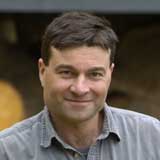 |
| Tom Henry recently wrote Following the Boulder Train. Photograph is by Robin Duncan. |
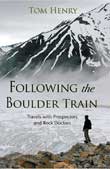 |
KH: How did you arrive at the book’s title, Following the Boulder Train?
TH: Following the boulder train is really a prospecting technique when you’re working in an area of post glaciation, where often the glaciers ripped off and spread about rocks in an alteration zone. Such zones are always interesting to prospectors — something’s been altered and you want to check out what’s happened. When glaciers retreat, they leave this trail of identifiable boulders back to the zone that you are interested in. Sometimes this can be 10 or 15 miles, maybe more.
So I was just following the boulder train. And when I came across one person in the industry who had an interesting story and they said you should talk to somebody else, I just followed that. I really followed my nose. Out of all the books I’ve written, I think this is the most intuitive one I’ve done, which is weird because it’s a science-related book.
KH: Has exploration always been an
integral part of the mining industry?
TH: Mining has an interesting dynamic. There was a lot of very profitable exploration and mining done in the 1960s and 1970s and effectively what happened in British Columbia and I think in the Western world, was that there was a bank account of ore bodies identified and through the 1980s and 1990s when exploration budgets and exploration were reduced, the mining companies effectively drew down on that account. They had an inventory of identified ore bodies that they could go and mine. Well, now we’re getting to the point where a lot of these existing mines are almost worked out. The inventory of identified ore bodies is not as great as it once was and hence there is a real impetus to start exploration projects again.
KH: The book seems to focus on people rather than some other aspect of exploration — why did you take that approach?
TH: Because I am more interested in the people and what drives them than I was in the geology itself. And I thought I could launder enough of the geology through talking about the people to make it at least a somewhat informative book. But of itself, how and why a rock formation occurred doesn’t interest me as much as the approach to understanding that a geologist takes.
KH: What did you find drives these explorers?
TH: I think it’s really almost a genetic inquisitiveness. Some people call it the treasure hunt, which implies you’re after the treasure. I think the best of the geologists just want to understand. They want to come up with a satisfactory answer for why a particular formation is the way it is.
KH: Can you tell me about some of the people you met? Is there one person who really stands out?
TH: I really liked a guy named Tim Sullivan, a prospector who was an utter violation of the clichés of the prospector. This was a guy who was hyper-literate in alternative music. On his months off from prospecting, he hung around the funky cafes in downtown Vancouver, which are homes for all sorts of modern lifestyles. He darn near worshiped martial arts and martial arts kind of philosophies, yet the guy was an incredible prospector — he really worked on intuition only. To work with him on the hillside was something else.
KH: I understand you spent some time at a prospecting school. Tell me about that.
TH: I think it might be the only school of its kind in the world, certainly the only one in North America. It fetched people from all over the place. We had a guy who taught Navajo Indian kids down on a reserve in Nevada. We had people from western Canada and all over the place who had come to this school.
One of the teachers was an iconic fellow, Dr. Tom Richards, an enormous guy who treats geology and understanding rocks as kind of a life philosophy. There was some science but there was also a lot of this Zen-like lore, like “you have to listen to the rocks,” and “if you go out looking for something that’s the wrong way to go about prospecting, you have to go out with your ears peeled.” Now that sounds very airy-fairy, but Tom also backed it up with a lot of rigorous skills that he tried to impart to us.
KH: Did that approach surprise you?
TH: Yes, very much. I knew he was a bit like this, sort of an old hippie. He was a former Geological Survey of Canada geologist. He had gone into the consulting business years ago and had this reputation for being a first-rate geologist and also a first-rate teacher.
We were immersed in prospecting for a week, we just lived it. You went to bed talking about rocks. You woke up, you’re having breakfast and somebody would plop a rock down beside the plate and we’d talk about it, and all the hours in between. That really did help my understanding. Rock identification and mineral identification is really tough.
KH: What is the state of the industry right now?
TH: [The industry] was really in the doldrums when I was researching the book, and now it’s going full guns. The price of gold has more than doubled. Throughout the book, [exploration] is mostly pegged on gold. These guys are always looking for gold and if they happen to come across something that has other value, that’s great.
Although the industry is going absolutely full tilt, they’re having trouble finding workers….The exploration community is having a hard time interesting young people in this. It’s hard work and it’s as cyclical as I’ve seen. You may go through some years of really hard times. …
A lot of geologists now are in their late forties, most of them are in their fifties, and there are not many that are younger than that. How are they going to pass on their knowledge? There’s university learning and then there’s in-the-field learning, and they’re two very different things. These guys will fade away and go into retirement without passing on their skills to a new generation of exploration geologists. It’s pretty concerning.
KH: What did you take away from this experience — would you consider a career change?
TH: My knees are too wrecked to change careers now. It’s very hard on the knees. But I really love how they have learned to read the landscape and read, what’s maybe more critical, below the landscape. They work hard physically and they work really hard mentally. It’s a rigorous discipline.
Mark Twain’s “Lost Cement Mine” no longer lost?
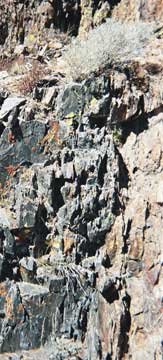 |
| In an outcrop above the discovery site of the Lost Cement Mine, a vein of marble converted to silica, bears red, weathered rock, as well as a form of fool’s gold. Researchers suggest that stories about the lost mine’s “gold” were a ruse to spur the finance of mining prospects in the area. Photograph is by Christer Loftenius. |
It was somewhere in the neighborhood of Mono Lake that the marvelous Whiteman cement mine was supposed to lie. Every now and then it would be reported that Mr. W. had passed stealthily through Esmeralda at dead of night, in disguise, and then we would have a wild excitement — because he must be steering for his secret mine, and now was the time to follow him.
The above excerpt from Mark Twain’s Roughing It, first published in 1872, describes his search through California’s Eastern Sierra Nevada wilderness for a purported bounty of gold contained in the Lost Cement Mine (cement was the word originally used by miners to describe a jumble of small stones cemented together). The lost mine captured the imagination of Twain, as well as journalists, who recorded details about the massive search for a vein that, according to Twain, was “…as wide as a curbstone, and fully two thirds of it was pure gold.”
Now, researchers say that clues recorded by Twain, journalists and historians led the team to locate the lost mine. The legendary mine, however, turned out to be a “ruse,” says Christer Loftenius, a geologist and environmental assessment coordinator in Los Angeles, Calif., who with software engineer Joe Skelly has been researching the mystery. Instead of gold, Loftenius says, the mine contains nothing more than a form of fool’s gold.
Today, most adventurers head to the Eastern Sierra Nevada to climb Mt. Whitney, ski at Mammoth Mountain, or hike through the volcanic and thermally active landscape. The region first started to grow in the mid-1800s, however, as the town then called Mammoth swarmed with prospectors and fortune seekers looking to strike it rich. From the thousands of hopeful prospectors arose stories of riches to be had, including the legend of the Lost Cement Mine.
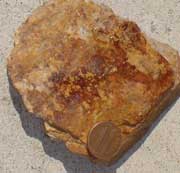
|
| A sample of the red “ore” pulled from the discovery site of the Lost Cement Mine matches descriptions found in literature, as well as newspaper and scholarly articles. Gold-colored flakes found in the rocks are not gold, rather they are white mica stained golden-yellow by iron oxides. Photograph is by Christer Loftenius. |
To try and locate the ore, Loftenius turned to an account of the ore’s discovery by James Wright, author of the 1984 The Lost Cement Mine. The story follows that in 1857, two miners stumbled upon the ore body as they hiked through the Sierra Nevada, hoping to find a shortcut from Death Valley to known mining towns. One of the miners collected samples of the red rock, which boasted gold-like flakes, and later sold it to a doctor in exchange for tuberculosis care.
From then on, the search continued: The doctor, armed with a map, gave up the search after two years, followed by a 20-year-long search by Gid Whiteman (described by Twain). During part of that time, however, two miners, Kent and McDougal, were mining the region in secret in 1877, when they saw prospectors approaching from the southeast, who were visible at the distance of nearly a kilometer, according to Wright. That piece of information would prove invaluable for Loftenius and colleagues’ discovery of the ore’s location.
Previous searches to date have focused on the area north of Mammoth Lakes, Calif., at the head of the Owens River. The Owens River flows southeast along the Long Valley Caldera — a 32-kilometer-long depression that formed 760,000 years ago when a volcano erupted with such force that the empty magma chamber below the volcano then collapsed. The river and Long Valley Caldera are bordered to the west by the San Joaquin Ridge, which is just north of Mammoth Mountain.
In accordance with Wright’s description of visibility to the southeast for up to a kilometer, Loftenius limited his search to the only area that fit this description: the caldera’s rim, as opposed to regions inside the caldera, he says.
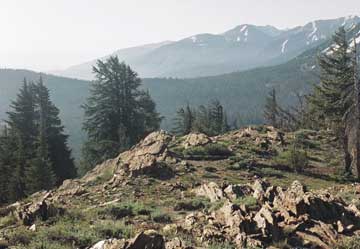 |
| The view from atop the cement spur and above the possible site of the Lost Cement Mine offers a glimpse of Mammoth Mountain and Long Valley in the Eastern Sierra Nevada. The area fits descriptions of the lost mine’s location as recorded by writers, such as Mark Twain. Photograph is by Christer Loftenius. |
With the historical accounts limiting the ore’s possible location, Loftenius next set out to determine if a gold deposit located north of the mountain would be geologically feasible. In the past, gold has turned up south of Mammoth Mountain resulting in the development of Mammoth Mine. Regions north of the mountain, at the head of Owens River and the supposed area of the Lost Cement Mine, however, are not known to host any sources of gold, Loftenius says.
Loftenius found one location in the designated area that would most likely support the formation and discovery of gold: a ridge of bedrock, called the cement spur, that was exposed as glaciers on both sides of the spur carved the east side of the San Joaquin Ridge. Upon limiting the search area to the cement spur, Loftenius and colleagues found rocks that matched the description of red rocks noted in the literature. The rock turned out to be marble, altered by volcanic activity. And inside cracks of the red marble, the team found that the “gold” was actually flakes of white mica that had been stained yellow by iron oxide to form a type of fool’s gold, Loftenius says.
Whether or not the cement spur was the location stumbled upon by the early prospectors and hunted down by successive treasure hunters, including Twain, will perhaps never be certain. Loftenius says, however, that the cement spur is the most likely location.
Loftenius also suggests that the legend was possibly perpetuated as a ruse to bring in investors to finance development of mining prospects north of Mammoth and build the economy, which continues to thrive today, not for its gold potential, but for its recreation and wilderness value — a feature that even Twain could appreciate.
Upon failing to follow Whiteman to the mine in secrecy, Twain described in his story how he and his cohorts “decided to make the best of our misfortune and enjoy a week’s holiday on the borders of the curious Lake…We hired a large boat and two shot-guns from a lonely ranchman who lived some ten miles further on, and made ready for comfort and recreation.”
Kathryn Hansen

 Subscribe
Subscribe

